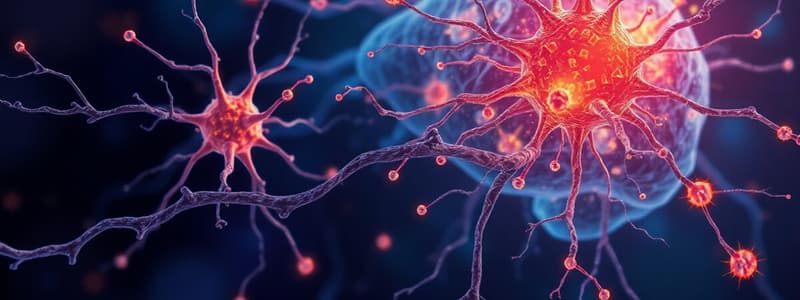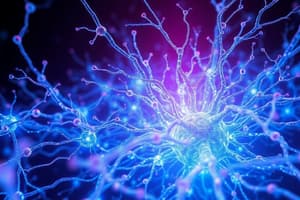Podcast
Questions and Answers
What are the three layers of connective tissue that cover nerve fibers?
What are the three layers of connective tissue that cover nerve fibers?
The three layers are Epineurium, Perineurium, and Endoneurium.
Estimate the approximate number of neurons in the spinal cord.
Estimate the approximate number of neurons in the spinal cord.
The spinal cord contains about 100 million neurons.
What is the primary role of the CNS regarding sensory information?
What is the primary role of the CNS regarding sensory information?
The CNS processes many kinds of incoming sensory information.
What is a nerve, and what does it consist of?
What is a nerve, and what does it consist of?
Define the term 'sensory receptor' in the context of the nervous system.
Define the term 'sensory receptor' in the context of the nervous system.
What role do interneurons play in the nervous system?
What role do interneurons play in the nervous system?
Describe the function of the myelin sheath.
Describe the function of the myelin sheath.
What type of synapse is formed between the axon of one neuron and the dendrite of another?
What type of synapse is formed between the axon of one neuron and the dendrite of another?
What is the significance of the Nodes of Ranvier?
What is the significance of the Nodes of Ranvier?
What is the primary function of the sensory or afferent division of the nervous system?
What is the primary function of the sensory or afferent division of the nervous system?
How many pairs of spinal nerves emerge from the spinal cord?
How many pairs of spinal nerves emerge from the spinal cord?
Explain the role of astrocytes in the nervous system.
Explain the role of astrocytes in the nervous system.
What type of connection is an Axosomatic synapse?
What type of connection is an Axosomatic synapse?
How do the somatic and autonomic nervous systems differ in terms of motor control?
How do the somatic and autonomic nervous systems differ in terms of motor control?
How do microglia contribute to the nervous system's defense mechanisms?
How do microglia contribute to the nervous system's defense mechanisms?
What role do enteric plexuses play in the autonomic nervous system?
What role do enteric plexuses play in the autonomic nervous system?
Can the enteric plexuses operate independently of the autonomic nervous system?
Can the enteric plexuses operate independently of the autonomic nervous system?
What is the central nervous system composed of?
What is the central nervous system composed of?
What types of sensory information does the afferent division of the nervous system convey?
What types of sensory information does the afferent division of the nervous system convey?
Identify the cells responsible for producing the myelin sheath in the CNS and PNS.
Identify the cells responsible for producing the myelin sheath in the CNS and PNS.
How does the autonomic nervous system typically interact with its two divisions?
How does the autonomic nervous system typically interact with its two divisions?
What is the purpose of ependymal cells in the nervous system?
What is the purpose of ependymal cells in the nervous system?
What distinguishes the sensory receptors mentioned in the content?
What distinguishes the sensory receptors mentioned in the content?
What specific voluntary actions are controlled by the somatic nervous system?
What specific voluntary actions are controlled by the somatic nervous system?
What are the two main branches of the autonomic nervous system (ANS)?
What are the two main branches of the autonomic nervous system (ANS)?
What role does the integrative function or 'PROCESS' of the nervous system serve?
What role does the integrative function or 'PROCESS' of the nervous system serve?
How does the autonomic nervous system differ from the somatic nervous system in terms of control?
How does the autonomic nervous system differ from the somatic nervous system in terms of control?
What are the protective structures that encase the brain and spinal cord?
What are the protective structures that encase the brain and spinal cord?
What is the function of the meninges in the central nervous system?
What is the function of the meninges in the central nervous system?
What types of muscles and glands does the autonomic nervous system primarily affect?
What types of muscles and glands does the autonomic nervous system primarily affect?
What are the four lobes of the cerebrum?
What are the four lobes of the cerebrum?
What brain structures are included in the diencephalon?
What brain structures are included in the diencephalon?
What is the primary role of the limbic system in the brain?
What is the primary role of the limbic system in the brain?
How does the hypothalamus contribute to homeostasis?
How does the hypothalamus contribute to homeostasis?
What is the function of the pineal gland within the epithalamus?
What is the function of the pineal gland within the epithalamus?
Describe the primary function of the cerebellum in the brain.
Describe the primary function of the cerebellum in the brain.
What is the significance of the medulla oblongata's location in the brainstem?
What is the significance of the medulla oblongata's location in the brainstem?
How do the oculomotor and trochlear nerves function in eye movements?
How do the oculomotor and trochlear nerves function in eye movements?
What distinguishes gray matter in the brain from white matter?
What distinguishes gray matter in the brain from white matter?
What role do the habenular nuclei play in the brain?
What role do the habenular nuclei play in the brain?
Flashcards are hidden until you start studying
Study Notes
### Association or Interneurons
- Are found in the brain and spinal cord
- Not specific to motor or sensory functions
- Play a role in integrating sensory information and generating motor responses
Dorsal Root/Spinal Ganglion
- A nodule on the dorsal root of the spine
- Contains cell bodies of neurons
- Carries signals from sensory organs toward the CNS
Motor (Efferent) Neurons
- Convey motor impulses from the CNS to effectors
MYELIN SHEATH
- Lipid-rich insulating material that surrounds axons
- Arranged in concentric layers
- Produced by Schwann cells in the PNS and Oligodendrocytes in the CNS
NODES OF RANVIER
- Points along the axon that are not myelinated
- Important for the rapid conduction of nerve impulses
Neuroglia (Glial Cells)
- Support and protect neurons
- Do not transmit nerve impulses
Astrocytes
- Provide structural support for neurons
- Regulate the chemical environment of the brain
- Help form the blood-brain barrier
Satellite Cells
- Specific to the PNS
- Surround neuron cell bodies in ganglia
- Provide support and insulation
Axoaxonic Synapses
- Synapses made by one neuron onto the synapse of another neuron
- Can influence the release of neurotransmitters
Ependymal Cells
- Line the ventricles of the brain and spinal cord
- Produce cerebrospinal fluid
Microglia
- Phagocytic cells of the CNS
- Remove debris and pathogens from the nervous system
ORGANIZATION OF THE NERVOUS SYSTEM
Central Nervous System
- Consists of the brain and spinal cord
- Processes sensory information
- Controls motor functions
- Responsible for higher cognitive functions (thinking, feeling, and memory)
Brain
- Located in the skull
- Contains approximately 85 billion neurons
Spinal Cord
- Connected to the brain through the foramen magnum
- Encircled by the vertebral column
- Contains approximately 100 million neurons
Peripheral Nervous System
- All nervous tissue outside the CNS
- Includes nerves and sensory receptors
- Relays information between the CNS and the body
Nerves
- Bundles of axons outside the brain and spinal cord
- Carry sensory and motor information
Cranial Nerves
- 12 pairs of nerves that emerge from the brain
- Responsible for sensory and motor functions of the head and neck
Spinal Nerves
- 31 pairs of nerves that emerge from the spinal cord
- Responsible for sensory and motor functions of the body
Sensory Receptors
- Structures that monitor changes in the external or internal environments
- Examples include touch receptors in the skin, photoreceptors in the eye, and olfactory receptors in the nose
Sensory (Afferent) Division
- Conveys sensory information from the body to the CNS
Somatic Senses
- Include touch, temperature, pain, and proprioception
Special Senses
- Include smell, taste, vision, hearing, and equilibrium
Motor (Efferent) Division
- Conveys motor output from the CNS to effectors
Somatic Nervous System (SNS)
- Controls skeletal muscles
- Responsible for voluntary movements
Autonomic Nervous System (ANS)
- Controls smooth muscle, cardiac muscle, and glands
- Responsible for involuntary functions
Sympathetic Division
- The "fight or flight" division of the ANS
- Prepares the body for stressful situations
Parasympathetic Division
- The "rest and digest" division of the ANS
- Promotes relaxation and energy conservation
Enteric Plexuses
- A network of neurons in the digestive tract
- Regulates the activity of smooth muscle and glands of the digestive system
Synapses
- Junctions between neurons where communication occurs
- Allow for the transmission of nerve impulses
Types of Synapses
- Axodendritic - axon to dendrite
- Axosomatic - axon to cell body
FUNCTIONS OF THE NERVOUS SYSTEM
Sensory Function (Input)
- Sensory receptors detect internal and external stimuli
- Information is carried to the CNS through cranial and spinal nerves
Integrative Function (Process)
- The CNS analyzes sensory information
- Makes decisions about appropriate responses
###Motor Function (Output)
- The CNS activates effectors (muscles and glands) through cranial and spinal nerves
- Causes muscles to contract and glands to secrete
BRAIN
Cerebrum
- The largest part of the brain
- Responsible for higher cognitive functions
Frontal Lobe
- Planning, decision-making, and voluntary movement
Parietal Lobe
- Processing sensory information
- Spatial awareness
Temporal Lobe
- Hearing and language
Occipital Lobe
- Vision
Diencephalon
- Located between the cerebrum and the brainstem
- Relays sensory information
- Regulates homeostasis
Thalamus
- Relays sensory information to the cerebrum
- Plays a role in consciousness
Hypothalamus
- Controls many body activities
- Regulates homeostasis
- Secretes hormones
Epithalamus
- Small region superior to the thalamus
- Contains the pineal gland, which secretes melatonin
- Involved in olfaction
Cerebellum
- Located posterior to the brainstem and inferior to the cerebrum
- Coordinates movement and balance
Brainstem
- Connects the cerebrum to the spinal cord
- Controls essential life functions (breathing, heart rate, and blood pressure)
Midbrain
- Superior part of the brainstem
- Involved in auditory and visual reflexes
Pons
- Located between the midbrain and medulla oblongata
- Relays information between the cerebrum and cerebellum
Medulla Oblongata
- Inferior part of the brainstem
- Controls vital reflexes, such as breathing, heart rate, and blood pressure
BRAIN ORGANIZATION
- The brain is organized into different regions that are specialized for different functions
PROTECTIVE STRUCTURES
- The brain and spinal cord are protected by the skull, vertebral column, meninges, and cerebrospinal fluid.
Skull
- Encases the brain, provides protection from injury
Vertebral Column
- Surrounds the spinal cord, provides protection from injury
Meninges
- Three membranes that lie between the bony encasement and the nervous tissue
- Provide additional protection and support
Cerebrospinal Fluid (CSF)
- Fluid that cushions the brain and spinal cord
- Helps to maintain a stable chemical environment
Limbic System
- A group of structures in the brain that are involved in emotions, memory, and olfaction.
Cranial Nerves
- 12 pairs of nerves that emerge from the brain
- Responsible for sensory and motor functions of the head and neck
Eye Movements
- The oculomotor, trochlear, and abducens nerves control eye movements
Grey Matter
- Contains neuronal cell bodies, dendrites, unmyelinated axons, axon terminals, and neuroglia
- Appears grayish because of the Nissl bodies
- Has little or no myelin
White Matter
- Contains myelinated axons
- Appears white due to the presence of myelin
Studying That Suits You
Use AI to generate personalized quizzes and flashcards to suit your learning preferences.




